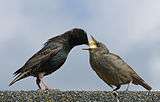Bottom feeder
A bottom feeder is an aquatic animal that feeds on or near the bottom of a body of water.[1] Biologists often use the terms benthos—particularly for invertebrates such as shellfish, crabs, crayfish, sea anemones, starfish, snails, bristleworms and sea cucumbers—and benthivore or benthivorous, for fish and invertebrates that feed on material from the bottom. However the term benthos includes all aquatic life that lives on or near the bottom, which means it also includes non-animals, such as plants and algae.[2] Biologists also use specific terms that refer to bottom feeding fish, such as demersal fish, groundfish, benthic fish and benthopelagic fish.[3] Examples of bottom feeding fish species groups are flatfish (halibut, flounder, plaice, sole), eels, cod, haddock, bass, grouper, carp, bream (snapper) and some species of catfish and shark.[3]

Feeding strategies
Some bottom feeders are detritivores.[2] This feeding strategy allows bottom feeders to take advantage of the dead organic material that drifts down through bodies of water to the floor.[1] In ocean environments, this downward drift of detritus is known as marine snow.[4] Bottom feeders may gather detritus manually, as some crab species do, or filter it out of the water using suspension feeding.[2] This recycling of organic matter is critical for the health of many aquatic environments as it helps maintain various biogeochemical cycles.[2] In 2014, it was reported that deep sea bottom feeders absorb carbon dioxide by eating creatures such as jellyfish and cephalopods, allowing the gas to be contained at the sea floor rather than be recycled back into the atmosphere.[5]
Other bottom feeders graze on living plants, as is the case in some sea urchin species.[6] Lastly, some bottom feeders are carnivorous and specialize in either hunting other bottom feeders and benthic animals, or scavenging from sunken bodies.[7]
Some carnivorous bottom feeders use the floor of their environment to ambush their prey.[3] One common method is the animal using body movements to cover itself with sand or sediment, then attempting to catch unsuspecting prey with fast strikes.[3] This tactic is used by many species of flatfish.[3] Other animals burrow into the bottom and hunt with most of the body remaining buried, as in the case of oceanic bobbit worms.[8]
Physiology
In fish, most bottom feeders exhibit a flat ventral region so as to more easily rest their body on the substrate.[3] The exception may be the flatfish, which are laterally depressed but lie on their sides.[3] Also, many exhibit what is termed an "inferior" mouth, which means that the mouth is pointed downwards; this is beneficial as their food is often going to be below them in the substrate.[3] Those bottom feeders with upward-pointing mouths, such as stargazers, tend to seize swimming prey.[9] Some flatfish such as halibut actually have a "migrating" eye that moves to the upward-facing side of the fish as it ages.[3]
Aquarium care
In the aquarium, bottom feeders are popular as it is perceived that they will clean the algae that grows in the tank. Generally, they are only useful for consuming the extra (fresh) food left by overfed or clumsy livestock; the added biomass of additional organisms means that the aquarium will likely be more dirty.[10] Some specialized bottom feeders are more specifically sold as "algae eaters" to increase the amount of free oxygen and aesthetic appeal of a tank.[11]
References
- "Bottom Feeders". David Suzuki Foundation. Archived from the original on 2016-10-28. Retrieved 2020-07-13.
- Baustian, M.M.; Hansen, G.J.; Kluijver, A.D.; Robinson, K.; Henry, E.N.; Knoll, L.B.; Rose, K.C.; Carey, C.C. (2015). "Linking the Bottom to the Top in Aquatic Ecosystems : Mechanisms and Stressors of Benthic-Pelagic Coupling". Cite journal requires
|journal=(help) - Bergstad, O. A. (2009). "Fish: Demersal Fish (Life Histories, Behavior, Adaptations)". In Steele, John H. (ed.). Encyclopedia of Ocean Sciences (Second ed.). Academic Press. pp. 458–466. doi:10.1016/b978-012374473-9.00673-1. ISBN 9780123744739. Retrieved 2020-07-13.
- Dash, Pragyan & Kashyap, Dipanjan & Mandal, Sagar. (2012). Marine snow: Its formation and significance in fisheries and aquaculture.
- Gannon, Megan (4 June 2014). "A New Reason to Love Bottom Feeders: They Suck Up Carbon". Live Science. Retrieved 27 October 2016.
- Norderhaug, Kjell & Christie, H.. (2009). Sea urchin grazing and kelp re-vegetation in the NE Atlantic. Marine Biology Research - MAR BIOL RES. 5. 515-528. 10.1080/17451000902932985.
- Mare, M. (1942). A study of a marine benthic community with special reference to the micro-organisms. Journal of the Marine Biological Association of the United Kingdom, 25(3), 517-554. doi:10.1017/S0025315400055132
- "Fish against Monster Worms". ScienceDaily. Universität Basel. 2016-09-21. Retrieved 2020-07-13.
- Kishimoto, Hirokazu & Last, Peter & Fujii, Eiichi & Gomon, Martin. (1988). Revision of a deep-sea stargazer genus Pleuroscopus. Japanese Journal of Ichthyology. 35. 150-158. 10.1007/BF02905400.
- Datta, Subhendu (2012). "Aquarium Water Quality Management". Training Manual on Ornamental Fish Breeding & Culture. 2: 34–49.
- Pedersen, Ole. (2011). The algal-free planted aquarium - grazing control. The Aquatic Gardener. 24. 32-39.

